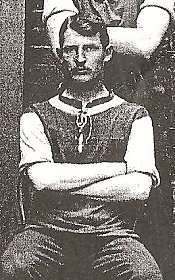

Location: Mericourt-l'Abbe is a village approximately 19 kilometres north-east of Amiens and 10 kilometres south-west of Albert. Heilly Station Cemetery is about 2 kilometres south-west of Mericourt-l'Abbe, on the south side of the road to Corbie.
Historical Information:The 36th Casualty Clearing Station was at Heilly from April 1916. It was joined in May by the 38th, and in July by the 2/2nd London, but these hospitals had all moved on by early June 1917. The cemetery was begun in May 1916 and was used by the three medical units until April 1917. From March to May 1918, it was used by Australian units, and in the early autumn for further hospital burials when the 20th Casualty Clearing Station was there briefly in August and September 1918. The last burial was made in May 1919. There are now 2,890 Commonwealth servicemen of the First World War buried or commemorated in this cemetery. Only 12 of the burials are unidentified and special memorials are erected to 21 casualties whose graves in the cemetery could not be exactly located. The cemetery also contains 83 German graves. The burials in this cemetery were carried out under extreme pressure and many of the graves are either too close together to be marked individually, or they contain multiple burials. Some headstones carry as many as three sets of casualty details, and in these cases, regimental badges have had to be omitted. Instead, these badges, 117 in all, have been carved on a cloister wall on the north side of the cemetery. The cemetery was designed by Sir Edwin Lutyens.
GUNNER HARRY ARCHIBALD HUXFORD, ROYAL GARRISON ARTILLERY

Portrait

H.A. HUXFORD
ROYAL GARRISON ARTILLERY
17TH SEPTEMBER 1916 AGE 29
Further Information
Harry Archibald Huxford was born on the 2nd of August 1887, the 3rd son of George and Emma Huxford. He was born in Cork, Ireland where his father was serving with the British Army. Harry's mother Emma died shortly after the birth of their daughter Elsie in 1893. George married again (Annie) and the family returned to their home town of Portsmouth where on leaving the Army, George was employed as an Aslyum attendant (by 1911).
Harry and his older brothers followed their father's footsteps and joined the Army. By 1911 Harry was in the Royal Garrison Artillery(26th Heavy Battery) so was already an experienced soldier when war broke out. Family history stories tell us that he had been promoted and "lost his stripes" during his service! He and his 2 brothers (George Ceil and Clifford) served in France during the Great War and apparently even met up there.
Sadly Harry was killed on the 17th September 1916. He had been out laying wire to an O.P. in front of Deville wood on the Somme battlefield when he was wounded by shrapnel. He was taken away from the front to the casualty clearing station at Heilly some 20 kms away. He died there the next day and is buried in the cemetery (Heilly Station Cemetery).
Both his brothers survived that war and stayed in Hampshire and all George's family carried on the military service tradition and Harry's Great Great nephew is currently (2011) serving with the Royal Engineers.
[Information supplied by Sarah Huxford, whose husband's great uncle was Harry Huxford, and the CWGC website]

